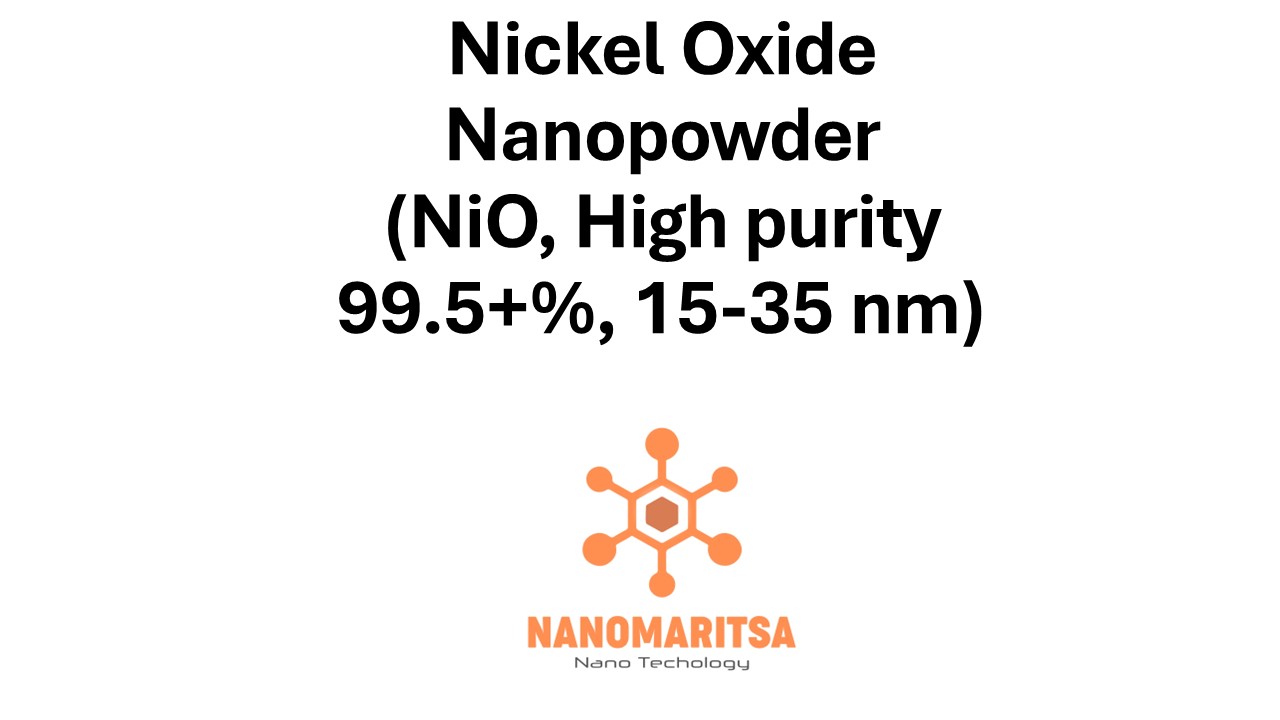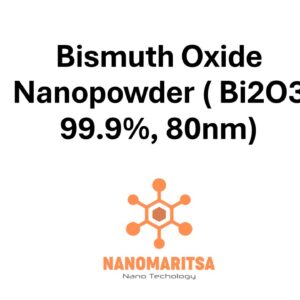Nickel Oxide Nanopowder (NiO, High purity, 99.5+%, 15-35 nm)
€100.00
CompareNickel oxide nanopowder (NiO, High Purity, 99.5+%, 15-35 nm) is a specialized material that exhibits enhanced properties at the nanoscale, making it highly effective in various advanced applications such as catalysis, energy storage, electronics, and environmental remediation. With high purity and a particle size range of 15-35 nm, this nanopowder offers improved reactivity, surface area, and stability compared to bulk NiO, providing significant advantages in performance and efficiency.
Composition and Structure
NiO (Nickel Oxide):
Nickel oxide is an inorganic compound composed of nickel and oxygen, existing primarily in the +2 oxidation state. When in nanopowder form, NiO exhibits enhanced surface area and reactivity, which makes it highly effective in a variety of applications, especially those requiring catalytic activity or electrochemical properties.
Purity (99.5+%):
With a purity of 99.5+%, this nickel oxide nanopowder has minimal impurities, ensuring high consistency and superior performance in applications requiring a precise and reliable material. The high purity ensures minimal contamination, which is crucial in industries such as electronics, energy storage, and catalysis.
Particle Size (15-35 nm):
The particle size range of 15-35 nm significantly increases the material’s surface area compared to bulk NiO. This nanostructure enhances the material’s reactivity and provides more active sites for chemical interactions, making it particularly useful in catalytic reactions, electrochemical applications, and sensor technologies.
Properties
- High Surface Area and Reactivity:
The small particle size of 15-35 nm increases the surface area of nickel oxide nanopowder, which enhances its chemical reactivity. This increased surface area improves the material’s efficiency in applications like catalysis, energy storage, and environmental remediation. - Electrical and Semiconducting Properties:
Nickel oxide exhibits semiconducting behavior, and in nanopowder form, its electrical conductivity can be tailored to meet specific requirements. NiO nanopowder is used in electronic devices, sensors, and energy storage systems, where its ability to conduct electricity can be optimized. - Catalytic Activity:
Nickel oxide is a well-known catalyst, particularly in oxidation reactions, hydrogenation, and energy conversion processes. The nanopowder form enhances the catalytic efficiency of NiO, making it more effective in applications such as fuel cells, pollution control, and chemical synthesis. - Thermal Stability:
NiO nanopowder demonstrates good thermal stability, allowing it to perform well in high-temperature environments without losing its catalytic properties or structural integrity. This makes it suitable for use in industrial processes and energy applications that require stability under elevated temperatures. - Magnetic Properties:
Though nickel oxide is antiferromagnetic at room temperature, its behavior may differ in nanopowder form, where the particle size and surface properties influence its magnetic characteristics. This makes NiO nanopowder useful in magnetic applications, including sensors and data storage devices.
Applications
1. Energy Storage and Batteries:
Supercapacitors and Batteries:
NiO nanopowder is used in the development of energy storage devices such as supercapacitors and lithium-ion batteries. The high surface area and electrochemical properties improve energy storage capacity and efficiency, leading to better charge/discharge cycles and longer battery life.
Fuel Cells:
Nickel oxide is a catalyst in fuel cells, where it helps convert chemical energy into electrical energy. The nanopowder form enhances the catalytic activity of NiO, improving the efficiency of fuel cell systems for clean energy production.
2. Catalysis and Chemical Reactions:
Oxidation Reactions:
NiO nanopowder is highly effective in catalyzing oxidation reactions, such as the oxidation of carbon monoxide in exhaust systems or the oxidation of hydrocarbons in chemical processes. Its increased surface area allows for faster and more efficient reactions.
Hydrogenation Reactions:
Nickel oxide plays an important role in hydrogenation reactions, where it facilitates the addition of hydrogen to organic compounds. This is important in the production of chemicals, pharmaceuticals, and food processing.
3. Electronics and Sensors:
Electrochemical Sensors:
NiO nanopowder is used in the fabrication of electrochemical sensors, which are designed to detect gases, chemicals, or changes in environmental conditions. Its semiconducting properties enable it to effectively interact with target molecules, making it valuable in environmental monitoring, safety, and industrial applications.
Memory Devices and Capacitors:
NiO is also used in memory devices and capacitors, where its ability to store electrical charge and its tunable electrical properties make it useful in electronic circuits and storage devices.
4. Environmental Applications:
Pollution Control and Waste Treatment:
NiO nanopowder is utilized in environmental applications such as air and water purification. Its catalytic properties make it effective in breaking down harmful pollutants, such as volatile organic compounds (VOCs), carbon monoxide, and nitrogen oxides, helping to reduce pollution.
Water Treatment:
Nickel oxide nanopowder is employed in water treatment systems, where it helps remove heavy metals, toxins, and other contaminants through adsorption and catalytic degradation processes. This makes it a valuable material in enhancing water quality and ensuring safe drinking water.
5. Materials Science and Nanotechnology:
Nanocomposites and Coatings:
NiO nanopowder is incorporated into nanocomposites and coatings to improve the mechanical, thermal, and electrical properties of materials. These composites are used in a variety of industries, including aerospace, automotive, and electronics, where enhanced materials are essential.
Magnetic Materials:
NiO is also used in magnetic materials, particularly in applications that require controlled magnetic behavior. Although NiO is antiferromagnetic, its nanoparticle form can exhibit different magnetic properties, which can be utilized in specialized magnetic devices.
Safety and Handling
Health Considerations:
Nickel oxide is considered toxic when inhaled or ingested, and exposure to dust or fumes should be minimized. Appropriate safety measures, such as using respiratory protection, gloves, and eye protection, should be taken when handling NiO nanopowder to prevent inhalation or contact with the skin.
Environmental Impact:
Like other nanopowders, NiO should be handled carefully to prevent environmental contamination. Research into the long-term environmental effects of nickel oxide nanopowder is ongoing, and proper disposal methods should be followed to minimize potential harm to ecosystems.
Summary
Nickel oxide nanopowder (NiO, High Purity, 99.5+%, 15-35 nm) is a highly versatile and reactive material with a broad range of applications in energy storage, catalysis, electronics, and environmental protection. Its high surface area, enhanced catalytic activity, and semiconducting properties make it particularly valuable in applications such as fuel cells, supercapacitors, pollution control, and electrochemical sensors. By utilizing the nanopowder form, the material’s efficiency and performance are significantly improved, contributing to advancements in various industrial, environmental, and technological fields.
| Measurement (gr) | 100 grams, 500 grams, 1000 grams |
|---|






